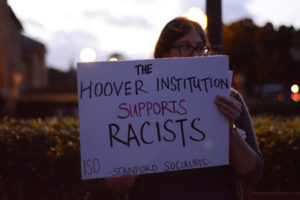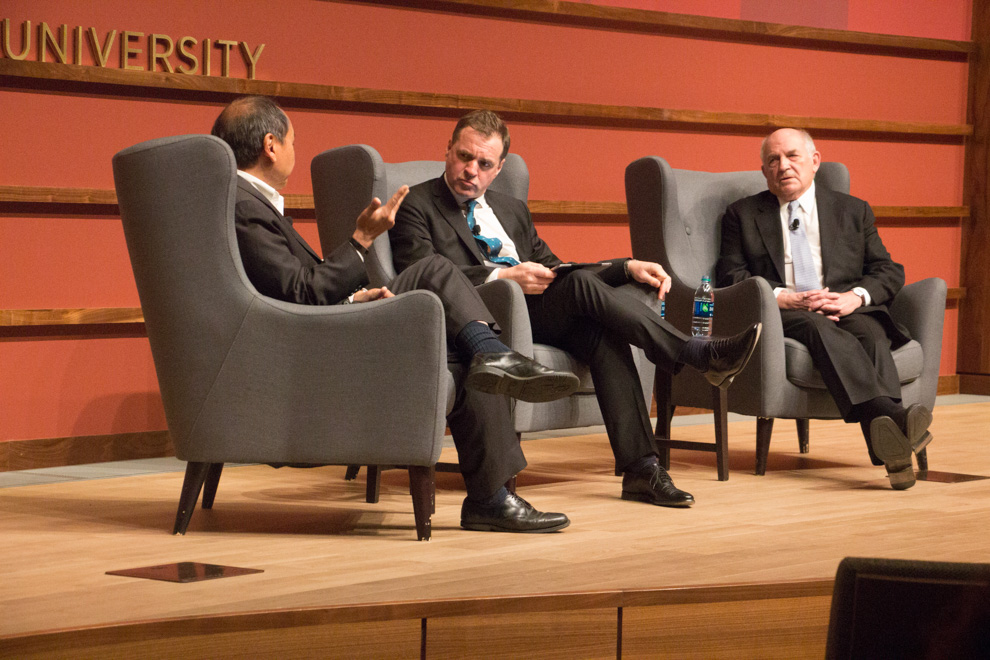Controversial social scientist Charles Murray and Freeman Spogli Institute senior fellow Francis Fukuyama discussed inequality and populism at the Hoover Institution on Thursday night in the second of four Cardinal Conversations, a program that aims to promote open political discourse on campus.
The event had visibly low attendance, with most of the back segment — around 100 seats — of the 400-person auditorium unfilled. Towards the front of the room, multiple reserved seats were left empty, as were several in the first row.
Meanwhile, across the street at the History Corner, “Take Back The Mic” counter-programming protested Murray and statements he has made regarding the relationship between class, race and intelligence.
Murray and Fukuyama in dialogue
Michael McFaul, director of the Freeman Spogli Institute and a co-leader of Cardinal Conversations, opened the event with a call for dialogue that is “challenging, intellectually and normatively.” He also called for more student engagement in the Conversations program, both in terms of leadership and audiences.
“I’m thrilled to see students here tonight, but there are not enough,” McFaul said.
Niall Ferguson, a senior fellow at the Hoover Institution, agreed. “As happened last time, many people seem to get tickets but then don’t show up,” he wrote in a statement to The Daily following the event, referencing the Jan. 31 Cardinal Conversation featuring Peter Thiel and Reid Hoffman. “Perhaps this was intended as some kind of protest, or perhaps it was just apathy — I don’t know.”
Ferguson continued, “What I do know is this: At Harvard or Oxford there would have been a full house.”
Additionally, he noted the counter-programming taking place directly outside the Hoover Institution and encouraged free speech for speakers and protesters alike.
“I think we all want to create the permissive conditions for inquiry, debate and even strong disagreement,” McFaul said. “We also want to respect other forms of speech, including peaceful protest of speakers… and boycotts of events like this one.”
However, he added, “We don’t respect actions that don’t allow people to speak.”
Ferguson then took the stage alongside Murray and Fukuyama. After introducing both speakers, Ferguson dove into one of the evening’s prescribed topics — inequality in America — by asking Fukuyama about his stance on American “plutocracy” and why the right, not the left, seems to have become the vehicle for white, working-class anger in the age of Donald Trump’s presidency.
“Now, unfortunately, I think the kind of identity politics that had been more on the left has now drifted over to the right,” Fukuyama said.
Trump — “a classic populist in the mode of Juan Perón or Mussolini” — won by capitalizing on that discontent, he added.
Ferguson then brought up the protesters outside who had gathered in opposition to Murray’s presence.
“I’m going to ask you absolutely upfront,” Ferguson said, addressing Murray. “Are you a racist and a sexist?”
Murray responded that he would not meet Ferguson’s conception of racist, wherein racism is the belief that certain groups are superior to others. However, he noted that under the “equality premise” — wherein “differences in group outcomes must be evidence of some sort of discrimination” — his argument in his 1994 text “The Bell Curve” that “there are differences in personality and abilities” both between and within racial groups would indeed label him a racist and a sexist.
In an interview with The Daily, Murray said that although he believes in racial disparities regarding intelligence, “to talk about the superiority of an ethnic group on the basis of some points of difference on IQ tests is idiotic.”
“To equate IQ with human virtue or wisdom or character or a whole variety of other of the most important measures of a value of a person is ridiculous,” he said. “IQ is equivalent to chip speed, and superior chip speed will enable certain things that inferior chip speed will not enable. The same is true about just about any human attribute you can think of that has no relationship to IQ whatsoever.”
Murray went on to defend the academic validity of the controversial book, although Fukuyama added that it would be “very imprudent” for an author to not consider “the impact that [a work] has on the broader society,” with “The Bell Curve” perpetuating white supremacy.
Ferguson then pivoted to the idea of class hierarchies and inequalities, citing Murray’s idea of a “cognitive elite” that has restructured society so as to perpetuate its own power.
“Along with not understanding the lives of ordinary Americans, the cognitive elite increasingly despises [them],” Murray said. “And I think that is at the heart of Donald Trump’s election.”
But populism, Fukuyama said, is not inherently bad; the anger fueling it can be directed towards positive change, like President Franklin Roosevelt’s welfare programs. Rather, Fukuyama identified the threat of populists as coming from their tendency to oppose institutions and checks on their power.
Other problems have fueled shifts in allegiance among working class whites, too. The speakers discussed changing pride in class identity, decreased intermingling between the elite and labor classes, and — as was made evident in Trump’s winning campaign — changes in immigration and demographics.
Writ large, the speakers disagreed on the root problem of these social ills.
“[Murray’s] explanation is completely cultural… and [he leaves] out all of the structural issues,” Fukuyama said.
But, Murray asked, “If economics is the main driver… shouldn’t a booming job market result in some rejuvenation?”
The night ended with a question and answer session, after which Ferguson promoted the next Conversation — which will feature Anne Applebaum and Ted Koppel — and thanked the students and staff who’d helped support the program.
Counter-Programming
Only a few hundred feet away from the Conversation, on the steps of The Quad’s History Corner and spilling out onto the surrounding pavement, students gathered to protest the event — and particularly Murray’s invitation to speak at Stanford — at the “Take Back The Mic” rally.
Michael Ocon ’20 organized the rally with the Coalition of Concerned Students to give students of color a platform to speak out against Charles Murray.
In an interview with The Daily, Ocon called Murray a eugenicist and accused him of making ethnic minorities feel vulnerable on campus.

“‘The Bell Curve’ isn’t the basis of our protest,” Ocon said. “Charles Murray is the basis of protest… This person is perpetuating white supremacy in the national discourse and in the local discourse.”
In the opening speech of the rally, Ocon said that protesters were here to stand against white supremacists, whom he believes have found a platform on campus.
“Our communities have been targeted on this campus by agents of racism, white supremacy and hatred,” Ocon said. “They targeted us in our dorms, in our classes, in our community centers. They disrespected and attacked our people at home and attempted to undermine our position at this University.”
Dereca Blackmon, associate dean and director of the Diversity and First-Gen Office, placed the Thursday rally in historical context, comparing it to a 1968 event in which members of the Stanford Black Student Union (BSU) took the microphone from then-Provost Richard Lyman during a speech and read aloud a list of demands.
“I’m here because as an administration we need to do better,” Blackmon said.
David Palumbo-Liu, professor of Comparative Literature, argued that Murray’s presence on campus was a symptom of the University undermining minorities.
“Universities welcome diversity, but they shut it down when it’s too real, too abrasive, when it could actually change the way that we understand things,” Palumbo-Liu said.
Earlier this year, The Stanford Review called on Palumbo-Liu to either resign or dissociate himself from his group, the Campus Antifascist Network.
During Tuesday night’s Undergraduate Senate meeting, ASSU Senate Chair Kojoh Atta ’20 encouraged his fellow senators to attend the “Take Back the Mic” rally. At the rally, fellow Senator Doris Rodriguez ’20 performed an original spoken word piece.
Student speakers represented organizations such as the BSU, American Indian Organization, Asian American Students’ Association (AASA), Muslim Student Union, Students for Justice in Palestine, International Socialist Organization, Jewish Voice for Peace and the Solidarity Network.
Zach Kirk ’20, an event organizer and BSU representative, said that Provost Persis Drell and President Marc Tessier-Lavigne’s support for the Murray event is a continuation of the University’s historical support for eugenics. Kirk pointed to David Starr Jordan and Lewis Terman as examples of former Stanford faculty who supported eugenics, yet still have their names featured on campus buildings today.
“I went to a middle school named after David Starr Jordan,” Kirk said. “If he had his way, if he was living today, he wouldn’t want me in this society. He wouldn’t have let me into this school.”
A March 2017 article in the New York Times clarified that Murray did not advocate eugenics in “The Bell Curve.”
Protesters addressed the administration directly, chanting the slogans, “Hey racists, go home!” and “Hey Persis, No Hoover, No KKK – Charles Murray, go away.”
They also chanted the second phrase with reference to Tessier-Lavigne instead of Drell.
Multiple speakers at the protest criticized Murray on academic grounds and for promoting “pseudoscience,” in the words of both Ocon and Blackmon.
“Stanford Medical School would not invite someone who believes that rubbing motor oil on your head will cure cancer,” Palumbo-Liu told The Daily. “[Murray is] not quite that bad, but there’s a certain quality of education we are proud of at Stanford, and this person doesn’t meet the bar.”
Protesters also stressed the need to make reforms to the Cardinal Conversation program. Kirk said that while he believes Cardinal Conversations is important, the committee that decided to bring Murray to campus was representative of neither the student body nor political spectrum on campus, adding that he and other protesters wanted to change this aspect of the program.
“We’re not only here to protest, we’re here to make internal change too,” Kirk said.
In an interview with The Daily, Palumbo-Liu criticized the prominence of the Hoover Institution in organizing Cardinal Conversations, arguing that it lent a partisan bias in the programming.
“I think it’s an interesting phenomenon that the University has decided to locate our discussion of free speech in a decidedly partisan institute,” Palumbo-Liu said. “That shows a certain imbalance.”
Murray’s appearance at Middlebury College on Mar. 2, 2017 turned violent when students and non-College affiliates disrupted his attempts to speak, resulting in a faculty member being injured. Following the incident, Middlebury took disciplinary action against 67 of its students.
Palumbo-Liu told The Daily that he was “not concerned” about any violence erupting at Stanford, emphasizing that Middlebury students and community members were specifically reacting to the college president introducing Murray.
“If David Duke were invited and Marc Tessier-Lavigne introduced him, you’d get upset, too,” Palumbo-Liu said.
Outside of Cardinal Conversations, other controversial speakers have been brought to campus and received financial compensation funded by ASSU student fees. In November 2017, Stanford College Republicans invited self-proclaimed Islamophobe Robert Spencer to speak about radical Islam, stirring similar controversy about free speech and inclusion. Nearly 300 Stanford community members organized a counter-protest and walk-out from Spencer’s speech, resulting in verbal and physical altercations.
In contrast, the Murray protest organizers did not plan a walk-out, and according to Ocon and Kirk, the counter-programming was primarily designed to uplift communities being targeted by Murray’s writings.
Michael Whittaker contributed to this report.
Contact Brian Contreras at brianc42 ‘at’ stanford.edu, Yasmin Samrai at ysamrai ‘at’ stanford.edu, Melissa Santos at melissasantos ‘at’ stanford.edu and Sarah Wishingrad at swishing ‘at’ stanford.edu.
